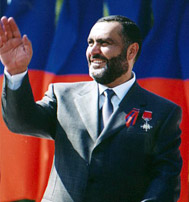Beginning in the previous eight editions
I had the opportunity to work in the same office as Vazgen Sargsyan for nearly two years. It was from 1987 to 1989. Vazgen was head of the publicity department of the “Garun” magazine, and I was one of the workers. My impression of him was that of an angry, yet sentimental man. Of course, he was not always angry and sentimental. Somewhere along the line he was rather pragmatic. It was a unique pragmatism-a little close to adventurism and a little far from rational. This gave him the opportunity to do impossible things and pretend that they are not impossible at all.
His initiative to unite the detachments or the call for 500 men ready to die (in the war) is proof of what I am saying. Unfortunately, another proof is Vazgen’s participation in the 1998 change of power. It was clear and understandable that Levon Ter-Petrosyan’s peace plan was not going to favor the defense minister, but becoming the main opponent was not due to the political discord, rather the confidence of turning the impossible into the evident. Vazgen was in the oppositional camp not because the victorious soldiers wanted that, rather because the demand for personalizing victory had emerged from the talk about peace.
Until February 3, 1998, when Ter-Petrosyan was reading the text of his resignation, Vazgen Sargsyan thought that he was going to replace the person who had refused to become a hero, but by February 4 it was clear that Sargsyan was the hero of Ter-Petrosyan’s election victory. As no army has ever had two commander-in-chiefs and cannot, Robert Kocharyan rushed to speak about himself as the “only man”, that there was no one in Karabakh who could stand up to him. That is why the pre-election propagandists spread the nickname “voin” (Russian for one who battles). Yet nobody who was in Karabakh during the war can explain who that means, Kocharyan or someone else.
In similar situations, soldiers not recognized for their victories commit suicide, but that was not a serious enough reason for Vazgen. Besides, he was still relying on his position of making the impossible evident. He realized that the victorious soldiers had remained faced off and ready to tear each other apart. The Vazgenian pragmatism, which was a little close to adventurism, and a little far from rational, started to work. Vazgen understood that in this struggle, the victory of the victorious soldiers was going to turn Robert Kocharyan into a super hero and under Kocharyan’s administration, whether he were Minister of Defense or Prime Minister, he would have the same status as a simple coal stoker. His job was going to be to keep the souls of the soldiers burning, regardless of the country’s socio-economic situation.
In the case of victory, Vazgen, Kocharyan and the victorious soldiers were going to go down in history, but more often the undeserving go down in history. In the created situation, the only solution could have been the assimilation of the people and the victorious soldiers, which was exactly what happened in spring ’99 when the Republican Party, headed by Defense Minister Vazgen Sargsyan, and the party of the masses, Karen Demirchyan’s Popular Party, joined to form the “Unity” alliance, whose slogan was clear: “Let’s defend and build”. There were two pieces of the Puzzle on the campaign posters of “Unity”; just two pieces which did not portray the entire image. It was hard to guess what kind of Armenia Sargsyan and Demirchyan were going to build, but the goal of the alliance was clear and understandable and it especially became clear during the pre-election assembly of the Republican Party, when Vazgen told his partisans that he was not going to go against Kocharyan.
“Don’t hold your breath,” he said in an angry tone, and made Kocharyan and the people understand that there will be no “clash of parties”. By making the promise not to get into confrontation, he also made it clear that he owns the victorious soldiers and that he, and only he, can restrain them and at some point, not restrain.
That point did not come due to October 27, 1999. Who organized the crime is not that important now, especially since any opinion is not going to be more than a guess. But one thing is clear: Vazgen Sargsyan’s Puzzle remained incomplete not because there was no total image, rather because there were no parts to the puzzle; there were no people there to defend and build it.
To be continued…

